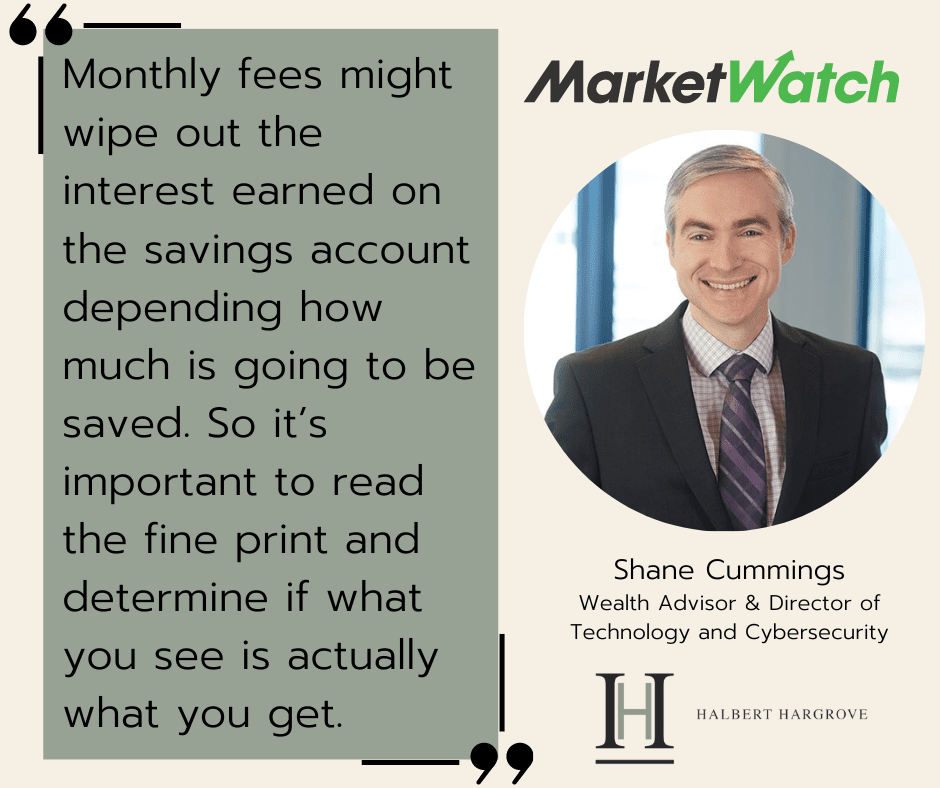By Andrew Shilling, MarketWatch featuring Shane Cummings, CFP®, AIF®, Wealth Advisor & Director of Technology/Cybersecurity
5 of the best high-yield savings accounts to consider now.
If you’re only saving $1,000 and your APY is 0.10%, that might not move the needle, however “if your savings is in the five figures or more, a higher APY could be more rewarding,” an expert said.
If you’re earning less than about 1.5% on your savings account right now, it’s probably time to make a change, pros say. “Banks are offering higher interest rates on savings accounts than they have in the past couple of years,” says Chanelle Bessette, personal finance specialist at NerdWallet. “Savers should be sure to do lots of comparison shopping and look into no-fee savings accounts that not only have high rates but are also convenient for you and your lifestyle.” You can see the best rates you may get on a savings account here.
Indeed, the annual percentage yield, or APY, of several savings accounts these days is hovering around and even surpassing the 2% mark. “Depending on how much money you can deposit, you can find accounts that are offering 2% returns or higher. That was unheard of not long ago,” Matt Schulz, chief credit analyst at LendingTree, recently told MarketWatch Picks. That is far above what even the highest-paying banks were paying last year, and far above the national average for banks right now. But how do you know which one is right for you?
Brick-and-mortar vs. online
While brick-and-mortar banks offer perks like face-to-face customer service, Gary Zimmerman, the CEO of cash-management platform MaxMyInterest, says that those options are often “rarely competitive when it comes to savings.” So, he adds: “That’s why you should supplement your existing banking relationship by opening bank accounts at online banks, which are able to pay higher yield since they don’t bear the costs of operating brick-and-mortar branches.” (You can see the best rates you may get on a savings account here.)
That said, there can also be some perks that come with the in-person option, like in-person service. If you want that, Bessette suggests making sure the bank you’re looking for has branches in your region and find the ones offering “special savings features like the ability to round up debit card purchases to the nearest dollar and save the difference. Some banks also let you set up sub-accounts so that you can save for specific goals in different buckets.” And she says, be sure to look for no-fee accounts that not only come with high rates, but ones that also match up with your lifestyle.
Understand the terms
Whether you decide to park your savings at an in-person or online bank, Shane Cummings, wealth advisor and the director of technology and cybersecurity at Halbert Hargrove, says it’s critical to understand a bank’s fee structure and any strings that may be attached. “Monthly fees might wipe out the interest earned on the savings account depending how much is going to be saved,” Cummings said. “So it’s important to read the fine print and determine if what you see is actually what you get.”
While banks like Amex Savings and Capital One don’t require opening a linked account and don’t have any hidden fees, Cummings said it’s important to keep in mind that some offer competitive rates but may try to sell you non-banking products once you open an account, like investment accounts. “This might not be a problem, but could be an annoyance to some,” he says.
Cummings added that knowing your rate in relation to the total amount you plan on saving over the next couple of years is also a crucial part of the decision-making process. If you’re only saving $1,000 and your APY is 0.10%, that might not move the needle, however “if your savings is in the five figures or more, a higher APY could be more rewarding.”


